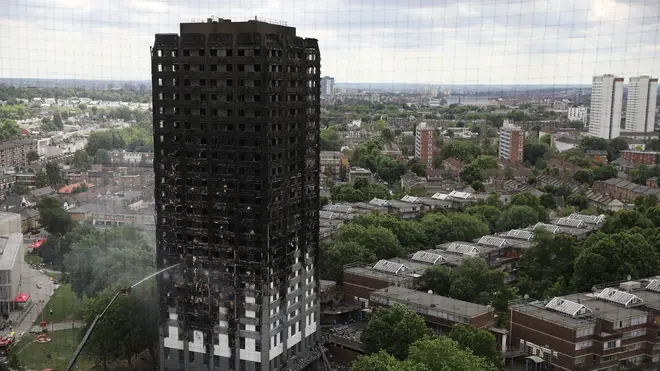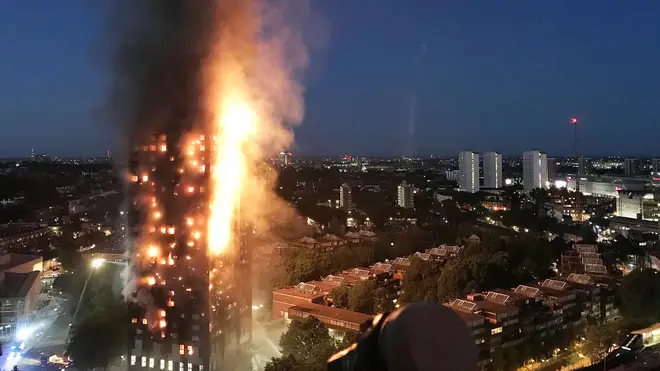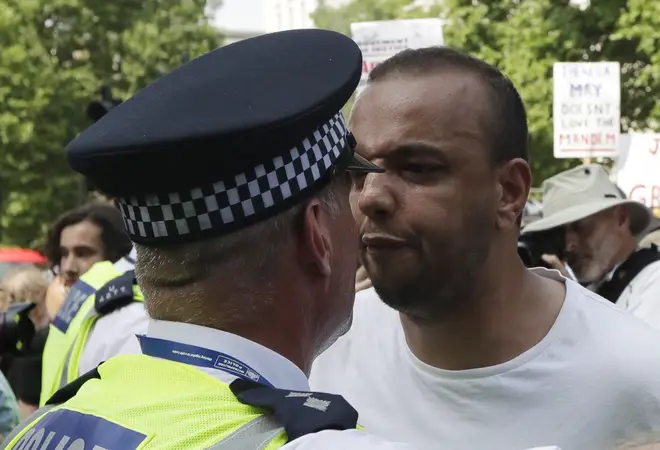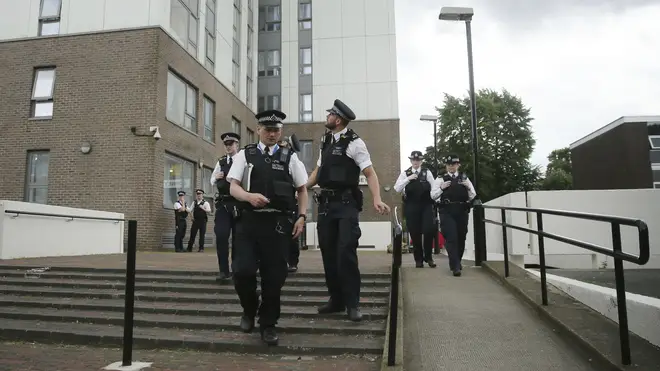
Ben Kentish 10pm - 1am
30 June 2017, 07:18 | Updated: 30 June 2017, 07:37

More than two weeks on and Grenfell Tower still stands as a ghastly monument to England, 2017. Matt Stadlen, who has lived in the area for decades, chronicles his attempt to get to the truth.
Each burnt out window seems to ask a different question. The flames that savaged the homes of hundreds also devoured what appears to have been a 21st century complacency that allowed 120 tower blocks and counting around the country to be clad in combustible material.
As survivors demand answers with increasing desperation, the ramifications of this human tragedy and its mishandled aftermath are unpredictable but far reaching. Individuals, institutions and the system itself, are all firmly in the firing line.
The big questions are obvious. How were at least 80 human beings able to lose their lives in a fire in central London almost two decades into the new millennium? Why do early indications suggest that Grenfell Tower was a disaster waiting to happen? Why isn’t it the law to retrofit sprinklers in all high-rise accommodation? Why do the appliances used by London Fire Brigade only extend to 32 metres, not tall enough to reach the upper floors of the block? How does it make any sense that the tallest aerial platform employed in the rescue operation was borrowed from Surrey Fire and Rescue Service (and itself unable to reach the higher floors of the 70 metre, 24-storey building)?
Why was the Prime Minister forced to admit that the initial response from both local and central government was ‘not good enough’? Why do some residents continue to feel let down by the authorities? Why have Kensington and Chelsea Council and the Tenant Management Organisation not told us or been able to tell us how many people lived in the block? Why has Scotland Yard not told us how many people have reported in safe from the tower? Why is the official number of presumed dead so much lower than some locals believe it to be? And why are survivors being rehoused in temporary accommodation in the first instance when many will no doubt crave certainty and security at such a distressing time?
I grew up and still live around the corner from Grenfell Tower. When I was a baby my GP’s surgery was in the tower itself and I later played football in its shadow for years. Only when the astroturf pitches at its base were removed to make way for its recent refurbishment did we shift a few hundred yards down the road to the Westway for our Tuesday night games. This is my community, these are my people. I was down on the ground in the four days after the first flames began to lick at the building, talking to survivors and to those who had lost loved ones, listening to their harrowing stories.
Stop for a moment and try to imagine their pain. Their disorientation. Their fear. One resident of the tower, who lived on the 15th floor, was pictured, as the flames still raged, holding a toothbrush and toothpaste in one hand and a charger lead and anti-heartburn medicine in the other. Another local told me of the screams he heard as the building burned.
I spoke to a woman as she sat waiting for news on a chair on the pavement who knew there was “no hope’ that the two families she was related to would turn up alive. Nonetheless, she wanted confirmation. Even by lunchtime on the day itself of the disaster a father shared with me his conviction that there was no chance his grown-up daughter could have survived on one of the higher floors.

As the scale of the tragedy was still sinking in, anger and frustration walked in the footsteps of grief. Why had the emergency services reportedly told people to stay put? Why had the fire spread so quickly? Why were the numbers of dead so low? Why were volunteers forced to adopt positions of responsibility? Why were there not council representatives outside each of the pop-up relief centres coordinating the response? Where was central government? Where was Theresa May? Why, when she did turn up, did she not stop to talk to furious residents in the street? Did the authorities really have a grip?
As it turned out, no they didn’t. Which, when you think about it, even given the scale of the disaster, is pretty shocking for one of the planet’s largest economies. My area was transformed overnight into a disaster zone that the developing world would justifiably have been ashamed of. Which isn’t to belittle the efforts of the local community or those who came from far and wide to help.
The sheer force of goodwill and generosity, the overwhelming desire among ordinary men and women to do their bit - more than their bit in many cases - was the one - wholly inadequate - consolation. People from a panoply of social, religious and ethnic backgrounds turned up to aid the stricken. The tragedy of Grenfell is, for some, a tale of two cities.
But I’ve always had faith in the mix of rich and poor in Notting Hill and the neighbourhood, including more affluent residents, stood up to be counted on that Wednesday and beyond.
Still, the questions persist. Consider the levels of mistrust of authority among those who have had their lives turned upside down and inside out by a fire that should never have happened. One local resident has already expressed to me his disappointment at the choice of Sir Martin Moore-Bick to lead the public inquiry announced by the Prime Minister.
Why, some will ask, is an ex-judge who is described as having a ‘controversial history in housing cases’ by the Guardian (which did also accept he ‘is widely respected within the legal profession’), been put in charge of such a sensitive case? Perception matters.
Grenfell residents are reportedly unhappy at not having been involved in the appointment and there is said to be concern over Sir Martin’s ruling in 2014 that Westminster City Council could rehouse a single mother-of-five more than 50 miles away near Milton Keynes. The decision was overruled by the Supreme Court in 2015. Local anxieties are not lost on Sir Martin himself who has already commented: ‘I'm well aware the residents and the local people want a much broader investigation and I can fully understand why they would want that - whether my inquiry is the right way in which to achieve that I'm more doubtful.’
There is nothing to suggest Sir Martin will not rule impartially on the facts, but suspicion of authority runs much deeper. There appears to be a widespread belief locally that the figures of the Grenfell dead are being deliberately suppressed.
Even the MP for Tottenham, David Lammy, while stopping short of alleging a cover-up, has tweeted that he will stand shoulder to shoulder with those survivors and members of the community who, he says, have explained how 79 - the figure has now risen to 80 - is an impossibly low number for the dead or presumed dead. How can people grieve without certainty that their loved ones have passed away? There is no doubt that the identification process of those who lost their lives in the intense heat of the fire is and will be a hugely complicated - and in some cases potentially impossible - process. But are the police being too cautious in not coming up with an estimate that better reflects what some locals strongly believe to be the truth?

The Met have announced that the list of residents provided to them by Kensington and Chelsea Tenant Management Organisation is inaccurate. Which seems an astonishing fact. The KCTMO managed Grenfell Tower. Wasn’t it their responsibility to know who lived in that building? And even if, for whatever reason, it is impossible to know how many people did live there, mustn’t it surely, as a matter of common sense, be possible for the police to reveal how many people have reported themselves safe?
I asked the Met for the figure in an email. Their response? ‘We understand the distress and desire for answers and remain committed to providing answers as soon as we possibly can.’
What the Met has so far revealed is that they have spoken to at least one occupant of 106 of the 129 flats in the block. ‘These people have been able to tell us not just who lived in those flats, but importantly who was in those flats on the night,” the police said. Eighteen people connected to those homes are dead or missing, presumed dead. ‘It is a terrible reality that there are 23 flats where despite huge investigative efforts, we have been unable to trace anyone alive who lived there. At this stage, we must presume, that no-one in those 23 flats survived, that includes anyone who lived there or was visiting them.’
It is possible that the number of dead will not exceed the already dreadful figure of 80. But could more be done to reassure survivors and others about the maths? When I emailed the head of communications at KCTMO questions about the numbers, his answer, after a stalling response and nearly two days later, was as follows.
‘As we continue to co-operate fully with the investigation into the tragic events at Grenfell Tower, Kensington and Chelsea Tenant Management Organisation (KCTMO) has to put on hold all requests for disclosure of relevant information. We recognise our responsibility to ensure that the investigative process is not hampered or undermined in any way.
‘Although KCTMO is a private body and therefore not subject to the Freedom of Information Act, we endeavour to follow the principles of the Act in the spirit of openness and transparency. We will continue to log all requests for disclosure and we will constantly review and take advice from investigating authorities with regard to answering as best we can all requests for information.’
Meanwhile, angry scenes yesterday greeted the Council’s decision to hold a private meeting. Survivors and other members of the public were reportedly barred from entering the building in a move that won’t have helped the mood among those who suspect a cover-up. The Council explained that its decision was based on the potential for public disorder after ‘protests at the Town Hall in the previous weeks’. However, after members of the press turned up soon after the start of the meeting - having acquired an injunction entitling them to do so - Council leader Nicholas Paget-Brown brought proceedings to an end, claiming their presence would ‘prejudice’ the public inquiry.
There is much work to be done both in the criminal investigation, which is up and running, and also, whatever its scope, in the public inquiry. The police have said that sixty ‘companies and organisations’ were involved in the refurbishment of Grenfell Tower. The same refurbishment, of course, that may turn out to have contributed to the fire’s spread.
What will also be looked at is the stark warning about fire safety that the Grenfell Action Group issued in November of last year. If the fatal blaze can be linked to mismanagement of fire safety concerns then there will be very serious consequences.
A man who lived in the tower for a month earlier this year and whose mother escaped from one of the lower floors, described the building to me as a ‘death trap’.
Whoever is or isn’t held accountable for the Grenfell Tower loss of life, there are even wider questions of public safety thrown up by the disaster. How can cladding from 120 high-rise buildings in 37 local authority areas in England have failed emergency safety tests set up since the fire? The Prime Minister has had to announce a 100% failure rate so far. What does this say about fire safety in this country and about the state of both local and central government?

I was live on LBC as thousands of people were evacuated from four Camden tower blocks last week because the fire brigade couldn’t guarantee residents’ safety. Communities and Local Government Secretary Sajid Javid revealed in the Commons this week that, among other failings, hundreds of fire doors were found to be missing in five Camden high rises. Again, this is London, 2017.
The tragedy of Grenfell Tower points to a national scandal that may yet implicate authorities at every level of public life. Governments past and present will rightly be scrutinised and asked whether they could and therefore should have done more to prevent what most - though not all - of us would have assumed to be an unthinkable loss of life in modern Britain.
Local government will also be asked searching questions. People are demanding accountability and will not tolerate being sidelined in the months and possibly years ahead. The TV cameras may mostly have rolled on for now but the spotlight will continue to be shone on the most distressing domestic disaster in my living memory.
It seems disgraceful that the BBC was forced to empty chair Kensington and Chelsea Council for the entirety of its two-hour programme presented from the local area two weeks on from the fire.
But those who might seek to hide know that the questions will keep coming and that national journalists and local residents like me will not rest until we are answered.